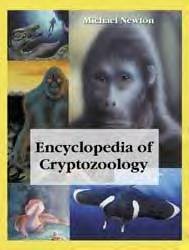
January 11, 2006
Solution d’un mystère de serpent de mer de Heuvelmans
In Bernard Heuvelmans’s classic In the Wake of the Sea Serpent, he revealed a minor mystery to keen readers. Specifically, on pages 114, 144 and 575, of the 1968 English edition of the book, Heuvelmans briefly mentioned a Sea Serpent sighting from 1782, by British troops at "Bagaduse."
Heuvelmans, within the text of his book, sourced the story with the Reverend Abraham Cunningham. Cunningham related an account, wrote Heuvelmans, of the "British on their expedition to Bagaduse" having seen a "Sea Serpent" reportedly "300 feet long." Heuvelmans considered that size exaggerated, as it stands out as extreme in a time when most Sea Serpents being seen off the coast of America were said to be 40 to 60 feet long.
Bernard Heuvelmans could never track down the location of "Bagaduse," and suggested in his book it might be a misspelling of "Bogalusa." Bogalusa is a landlocked town in Louisiana, which later would become infamous for its KKK (racist) activity.
Recently, cryptozoological author Michael Newton contacted me, mentioning the Bagaduse mystery, anew. Exchanging emails, Mike wrote: "Long story short, while reading Robert Heinl’s Soldiers of the Sea–a history of the US Marine Corps–I stumbled on a reference (p. 9) to a skirmish between jarheads [Marines] and redcoats [British] at Bagaduce Heights in July 1779. Apparently its in Maine, at or near the site of present-day Castine, on or near Penobscot Bay. This fits perfectly with the time frame of Bernard Heuvelmans’s report and also with the rash of 18th century New England Sea Serpent sightings."
As fate would have it, I live in Maine and was one day away from traveling "downeast" to the Castine area. I decided to do some field and local investigations of this Bagaduse – Bagaduce mystery.
The locals, of course, quickly put me on the right track. It was "Bagaduce," not "Bagaduse," and only someone "from away" would make that "wicked silly" mistake, I was told in thick Downeast accents.
So, it appears Heuvelmans had merely repeated an old spelling of the area, or more likely, a misspelling of the location in a retelling of the British "adventure" in Maine. Today, throughout the region as you move in from the ocean, inland from Penobscot Bay, you hear of the "Bagaduce" (not "Bagaduse").
The Bagaduce River flows through the small town of Penobscot and empties into Penobscot Bay at Castine Harbor, about 25 miles northeast of Rockland, Maine. The Bagaduce River is viewed by the locals as an extraordinary body of water that graces the shores of Castine, Penobscot and Brooksville, Maine, well known for its local wildlife. Today, traffic on the river consists of recreational craft, fishing boats, and training vessels of the Maine Maritime Academy in Castine.
The Bagaduce River is in Maine today, but technically, in 1782, it was in the Commonwealth of Massachusetts. During the British battle at Bagaduce in 1779, the area was really in Massachusetts. Perhaps this too has confused those seeking Heuvelmans’ mysterious "Bagaduse"?
Maine did not become a state until 1820, the 23rd state to join the United States of America. What is now the state of Maine was, before statehood, called the District of Maine and belonged to Massachusetts.
Heuvelmans gave a hint that the "Bagaduse" sighting belongs in Maine. If you examine his "Chronological Table of Sightings" beginning on page 575, of In the Wake of the Sea Serpent, Penobscot Bay dominates the list around the year 1782.
Sea Serpents were sighted in Penobscot Bay and near Maine in 1751, 1773, 1779, 1780, 1787, 1793, 1794, 1799, 1811, 1817, and 1818. Intriguingly, the vast number of sightings moved from the less populated areas of Downeast Maine to the more densely peopled locations of Portland, Maine, and Gloucester, Massachusetts, during the wave of 1817-1818. Before those two years, Penobscot Bay, Maine was the number one East Coast location for Sea Serpent sightings in the second half of the 18th century.
Portland’s Cassie, as I mention in my field guide on Sea Serpents, may have become more well-known in Maine, but the Penobscot Bay and the Bagaduce beasts were more frequent visitors to the "District of Maine."
The Heuvelmans mystery of "where is Bagaduse" can be filed away now. Onward to the next riddle.

+ + +
I appreciate working, during this mutual investigation, with Michael Newton, author of Encyclopedia Of Cryptozoology: A Global Guide To Hidden Animals And Their Pursuers . I thank Michael for sharing his insights.

About Loren Coleman
Loren Coleman is one of the world’s leading cryptozoologists, some say “the” leading living cryptozoologist. Certainly, he is acknowledged as the current living American researcher and writer who has most popularized cryptozoology in the late 20th and early 21st centuries.
Starting his fieldwork and investigations in 1960, after traveling and trekking extensively in pursuit of cryptozoological mysteries, Coleman began writing to share his experiences in 1969. An honorary member of Ivan T. Sanderson’s Society for the Investigation of the Unexplained in the 1970s, Coleman has been bestowed with similar honorary memberships of the North Idaho College Cryptozoology Club in 1983, and in subsequent years, that of the British Columbia Scientific Cryptozoology Club, CryptoSafari International, and other international organizations. He was also a Life Member and Benefactor of the International Society of Cryptozoology (now-defunct).
Loren Coleman’s daily blog, as a member of the Cryptomundo Team, served as an ongoing avenue of communication for the ever-growing body of cryptozoo news from 2005 through 2013. He returned as an infrequent contributor beginning Halloween week of 2015.
Coleman is the founder in 2003, and current director of the International Cryptozoology Museum in Portland, Maine.
Filed under Books, Breaking News, CryptoZoo News, Cryptozoology, Media Appearances, Sea Serpents